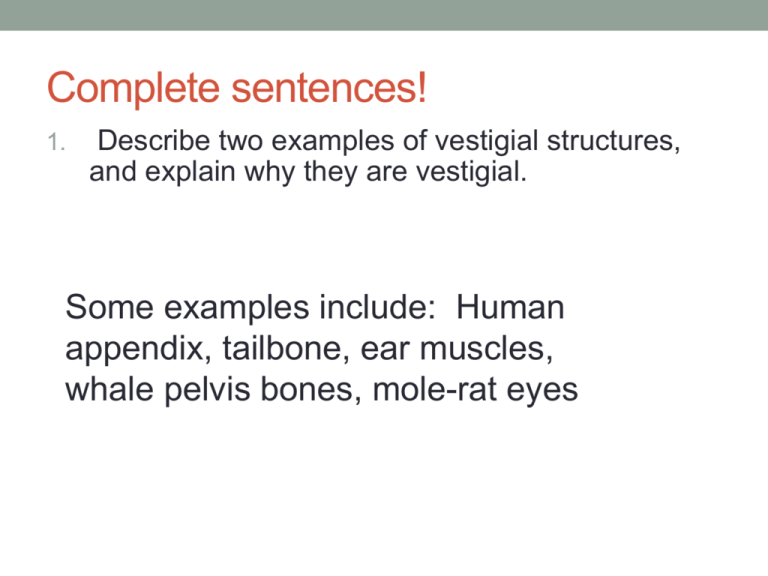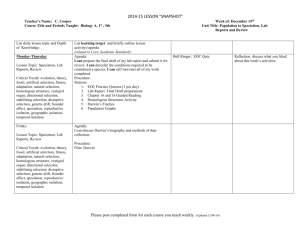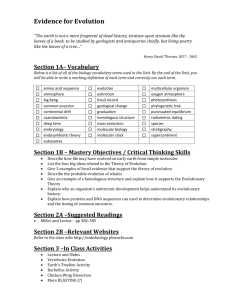Evolution Review
advertisement

Complete sentences! 1. Describe two examples of vestigial structures, and explain why they are vestigial. Some examples include: Human appendix, tailbone, ear muscles, whale pelvis bones, mole-rat eyes You must answer in a complete sentence! 2. Write one or two sentences that relate the following vocabulary terms: Adaptation, Fitness, Speciation, Evolution. Please underline each vocabulary word used. An adaptation will improve the fitness of an organism. The resulting evolution of a population with that adaptation may become different enough from the original population, therefore causing speciation. You must answer in a complete sentence! 3. Write one complete sentence comparing and one complete sentence contrasting Homologous and Analagous structures. Homologous and analogous structures both describe features that look similar between two species. Homologous structures develop because of inherited traits that were shared by a common ancestor, while analagous structures develop because of inherited traits that evolved independently. Answer the question! 4. What are the three types of Selection? Describe a specific example for each. Directional Selection—Thick-haired chipmunks survive better in a cold environment, average thickness of hair increases over time Stabilizing Selection—Bats with average-length wings succeed more since short wings provide less lift, but long wings don’t fit well in a small cave when flying, wing length stays the same over time Disruptive Selection—Small and large root systems in blackberry plants succeed more than medium size roots since small roots can establish in sidewalk cracks, and large roots can reach lower sources of water in the unpaved areas. Over time two groups of plants with extreme features become more common. Answer the question! 5. What are the three types of Isolation? Give an example for each (but different than those given in the book). Behavioral Isolation—Insects with different mating dances avoid reproducing with each other Geographic Isolation—Groups of fish live in different lakes and cannot reproduce with each other Temporal Isolation—Flocks of birds visit a breeding ground at different times of year and therefore cannot reproduce with each other Write a Story! 6. Make up an example of natural selection at work. Describe how it could take a population of a single species and produce two different species. Predation, Defense, or Sexual Selection Write a Story! 7. Change your natural selection scenario so that it involves artificial selection instead. Artificial Selection would involve non-natural interference with the selection that happens Make a list! 8. List two things that could help natural selection occur more quickly and describe how they would. Could include: Overproduction, Variation, Competition Write a list 9. List three topics that are used as evidence for the evolutionary concept of common ancestry between diverse species. For instance: Transitional Fossils, Locations of Present-Day Species, Geologic Data, Anatomical Comparisons, Embryology, Genetic Comparisons NO NEED for complete sentences! 10. Copy the four sequences into your notebook. Which two of the following DNA sequences must belong to the most closely related species? 1. 2. 3. 4. TA G G G A C C C TA A G G A G T C T TA G G A A G C TA C G G A C C C NO NEED for complete sentences! 10. Copy the four sequences into your notebook. Which two of the following DNA sequences must belong to the most closely related species? 1 . TA G G G A C C C 2 . TA A G G A G T C 3 . T TA G G A A G C 4 . TA C G G A C C C *only one base differece between #1 and 4 NO NEED for complete sentences! 11. Put the four species below into a cladograph based on their hypothesized evolutionary relationships 1. 2. 3. 4. TA G G G A C C C TA A G G A G T C T TA G G A A G C TA C G G A C C C NO NEED for complete sentences! 11. Put the four species below into a cladograph with their hypothesized evolutionary relationships 3 2 4 1 *Species 1 and 4 only have one base different, but Species 2 has three bases different from 1 and 4, and Species 3 has four bases different Answer the question! 12. What could have been the theoretical cause for variation between the DNA segments in the four species in the last two questions? Mutations that occur over generations after speciation events.







